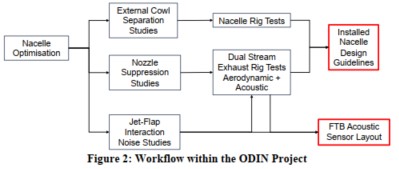As introduced in Section 1.3.1, the Topic description calls for research into a number of areas that are key for understanding the behaviour of installed UHBR nacelles operating at off-design conditions, broadly summarised as: nacelle geometries and design guidelines; external cowl separation; exhaust nozzle suppression; and acoustics, primarily concerned with jet-flap interaction noise. This section breaks down in more detail the methodology to be followed in project ODIN. Figure 2 depicts the overall workflow, which illustrates the links between the different activities. This highlights how the project is aligned to delivering its critical outputs (outlined in red) and how the work performed will build up to these outcomes, principal among which is a set of guidelines for designing nacelles to account for off-design performance when installed.

The specific technologies and approaches to be deployed by the Consortium are detailed below, as well as how the integrated approach taken in the ODIN project combines each partner’s expertise to deliver the best results. This will demonstrate the proven track record of the methods used and how the innovative steps to be taken in ODIN will satisfy the objectives laid out in the Topic description and advance the relevant state-of-the-art in each area. The following discussion details how all Consortium members “have substantial technical knowledge in the domain of the proposed tasks”, have “demonstrated expertise in project participation, international cooperation, project and quality management” and have a “proven achievement record showing knowledge is recognised by scientific community”, as required in the Topic description.